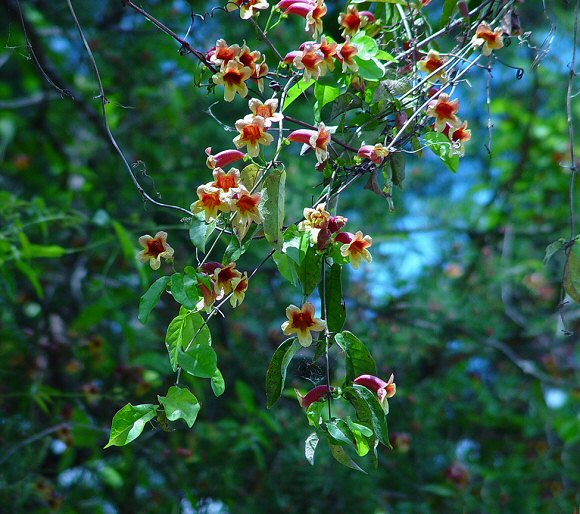Bignonia capreolata L.
Cross Vine

Native
CC = 6
CW = -3
MOC = 9
© DETenaglia
Bignonia capreolata L.Cross Vine | |
 |
Native CC = 6 CW = -3 MOC = 9 |
© DETenaglia |
|
Family - Bignoniaceae Habit - Lianas, creeping or climbing, with leaf tendrils, lacking adventitious rootlets Stems - Creeping and climbing, to 25 m, glabrous or inconspicuously hairy at the nodes, finely ridged, the older ones often angled, the dark grayish brown bark becoming wrinkled and sometimes peeling in thin, papery strips.
Leaves - Opposite, compound with 2 lateral leaflets and a terminal, branched tendril, short-petiolate. Leaflets 4-18 cm long, lanceolate to elliptic or oblong-ovate, shallowly cordate at the base, rounded or more commonly tapered to a sharply pointed tip, the margins entire or slightly irregular, the surfaces glabrous or sparsely pubescent with minute, unbranched hairs along the main veins
Inflorescence - Axillary clusters. Flowers - Calyces 6-9 mm long, shallowly 5-lobed or unlobed, glabrous or minutely hairy along the margin, reddish green, the lobes (when present) much shorter than the tube, broadly and bluntly triangular. Corollas 4-5 cm long, somewhat zygomorphic, glabrous or more commonly minutely hairy on the outer surface, somewhat thickened, red to reddish orange on the outer surface, yellow to yellowish orange on the inner surface, 5-lobed, only slightly 2-lipped, the tube narrowly bell-shaped and slightly bent toward the middle, the lobes much shorter than the tube, the margins entire or slightly irregular. Stamens 4. Pistil 1 per flower, of 2 fused carpels. Ovary superior, with 2 locules, the placentation usually axile. Style 1 per flower, the stigma 1, with 2 deep flaplike lobes. Ovules numerous.
Fruits - Capsules 10-20 cm long, flattened, narrowly elliptic in cross-section, longitudinally dehiscent, the 2 valves glabrous, with a leathery texture, and tan to brown at maturity. Seeds with the body 7-10 mm long, flattened, the body elliptic in outline, 2-lobed, brown, with a wing around the middle (longest at each end) or less commonly only at the ends, the wings papery, light tan, with irregular margins. Flowering - April - June. Habitat - Low woods, bottoms, swampy ground, thickets along streams, low fields, fence rows. Origin - Native to the U.S. Lookalikes - Flowers are similar to Campsis radicans, but with yellow instead of red interiors. Leaves are also completely different. Other info. - This is a species of the southeastern U.S., with the bootheel of Missouri lying at the northwestern edge of its range. It is relatively uncommon in Missouri and has seldom been collected in the state in recent years. It is an attractive plant, easily identified in the field by its opposite bifoliate leaves, which have a tendril located between the two leaflets. The leaves are evergreen or nearly so. The flowers are often found lying on the ground underneath large trees where the vine is growing. The showy and fragrant flowers and unusual foliage argue for more widespread cultivation as a garden ornamental. The common name "cross vine" derives from a cross-shaped pattern visible in transverse sections of older stems. Photographs taken in Brown Summit, NC., 5-2-02 and 4-9-03 (DETenaglia); also at Poplar Bluff Conservation Area, Butler County, MO, 5-15-2016 (SRTurner). |